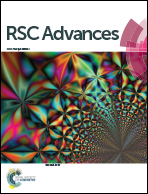Discovery of 4-benzoylpiperidine and 3-(piperidin-4-yl)benzo[d]isoxazole derivatives as potential and selective GlyT1 inhibitors†
Abstract
Regulation of glycine transporter 1 (GlyT1) activity is a currently investigated strategy in drug discovery for schizophrenia. This study developed a series of new 4-benzoylpiperidine derivatives as GlyT1 inhibitors by bioisosteric replacement and mimicking of the pyridine ring of RG1678. Among the 4-benzoylpiperidine derivatives, 23q showed an IC50 of 30 nM. Preliminary optimization of the blood–brain barrier penetration led to the discovery of 3-(piperidin-4-yl)benzo[d]isoxazole derivatives. Both series showed good selectivity over GlyT2, D1, D2, D3, 5-HT1A and 5-HT2A receptors. Moreover, behavioral testing showed 23q (40 mg kg−1, intragastric) can inhibit the hyperlocomotion induced by acute treatment of phencyclidine, and improve the impaired negative and cognitive symptoms in chronic phencyclidine-induced C57BL/6J mice. An interesting finding showed that 3-(piperidin-4-yl)benzo[d]isoxazole was a privileged scaffold of atypical antipsychotic agents but exhibited high selectivity and potency as a GlyT1 inhibitor.
![Graphical abstract: Discovery of 4-benzoylpiperidine and 3-(piperidin-4-yl)benzo[d]isoxazole derivatives as potential and selective GlyT1 inhibitors](/en/Image/Get?imageInfo.ImageType=GA&imageInfo.ImageIdentifier.ManuscriptID=C5RA04714E&imageInfo.ImageIdentifier.Year=2015)

 Please wait while we load your content...
Please wait while we load your content...